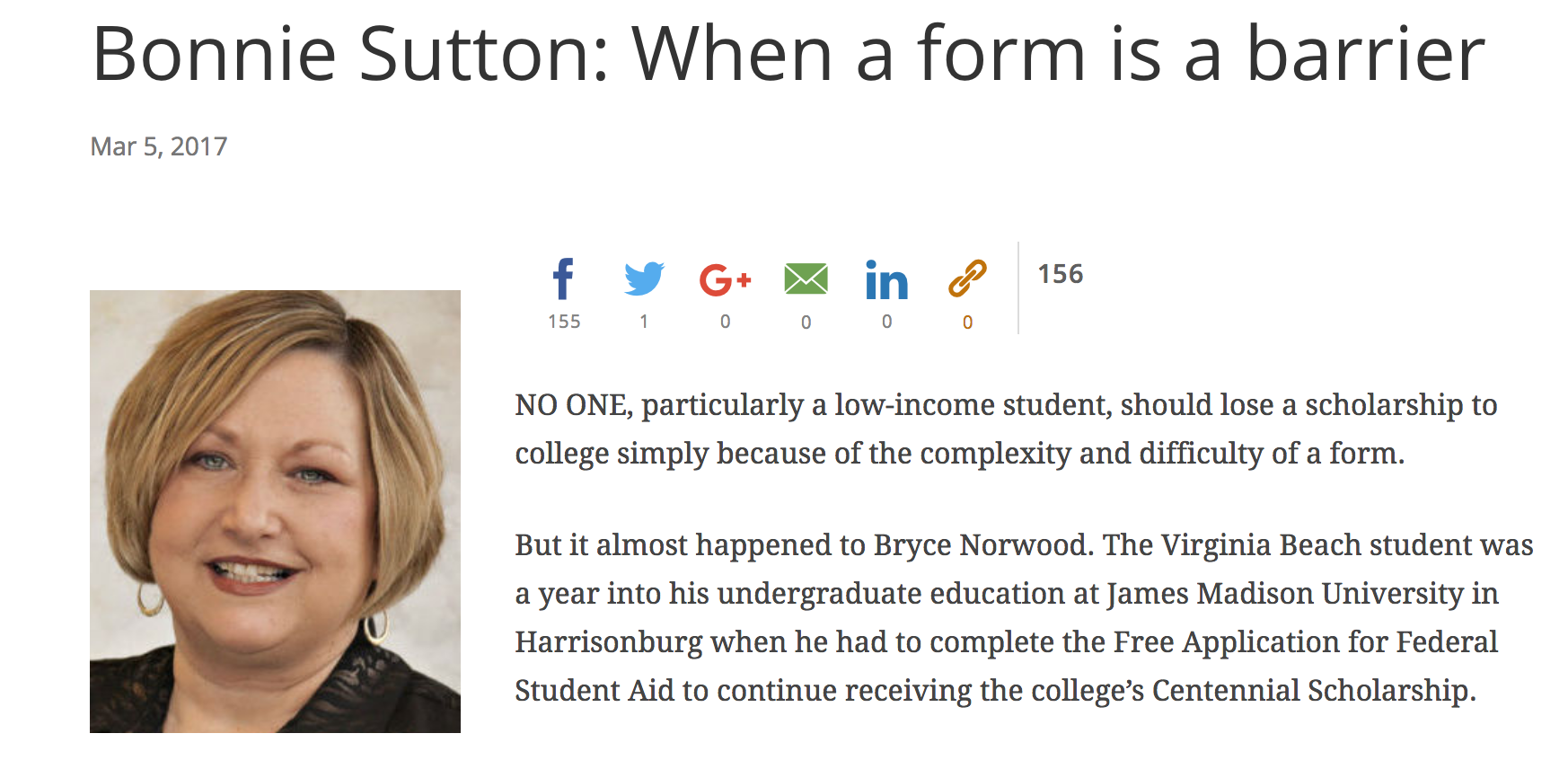OUTLET: The Virginian-Pilot
NO ONE, particularly a low-income student, should lose a scholarship to college simply because of the complexity and difficulty of a form.
But it almost happened to Bryce Norwood. The Virginia Beach student was a year into his undergraduate education at James Madison University in Harrisonburg when he had to complete the Free Application for Federal Student Aid to continue receiving the college’s Centennial Scholarship.
My agency, the ACCESS College Foundation, helped him secure it coming out of high school.
Thinking he could manage the FAFSA alone in advance of his sophomore year was nearly Bryce’s undoing.
“I misinterpreted the information requirements and input invalid responses that led to an incorrect evaluation of my financial situation,” he recalls. “As a result, I lost my scholarship, and my life took a drastic turn for the worse.”
Fortunately Bryce reconnected with ACCESS, we corrected his form and we intervened with JMU to re-instate the assistance.
In early February, Bryce and I went to Washington, D.C., as part of a panel presenting the results of a study and prototype of a new FAFSA form created and tested by the National College Access Network. The full report entitled “Half the FAFSA: Cutting the Red Tape to Postsecondary Student Aid” can be found at www.collegeaccess.org/fixfafsa.
The problem is that the FAFSA form, which enables millions of young people to apply for financial aid, is too often a barrier because of its complexity, particularly for low-income and first-generation students. Currently only 44 percent of high school seniors complete the FAFSA, meaning that $24 billion in federal aid, including $2.7 billion in Pell grants, goes unclaimed.
Carlos Jimenez-Vasquez, a freshman at Appalachian State University said, “The FAFSA was just a riddle that had to be solved.”
With no parental knowledge to lean on, he noted that it took him more than a week to complete and that he couldn’t have done it without the help of his college adviser from another NCAN agency.
Stacy Lightfoot and Dr. Yolanda Watson Spiva, who run college access and success programs in Chattanooga, Tenn., and Washington State, respectively, note that there aren’t enough people doing this kind of work to help every low-income student.
The ACCESS College Foundation and other similar programs spend a large amount of time helping our students complete this one form. What about students who don’t have access to this type of assistance?
A key benefit to fixing the FAFSA would be freeing up more time to focus on “fit and match” with students’ career goals and suitable colleges. It would also allow us time to start helping students as high school freshmen or earlier — not as high school seniors.
There have been improvements to the process over the past couple decades, for instance allowing the skipping of unnecessary questions based on an individual’s financial circumstances and enhancement of the IRS Data Retrieval Tool.
Yet, even with those improvements, the FAFSA still has more than 100 questions that stand between students and the aid they must have to go to college.
Why is this such an important issue for me and other practitioners? Because high school graduates who complete the FAFSA are 63 percent more likely to enroll in college than those who do not. Research also indicates that FAFSA filers typically stay in college and graduate with degrees that enable them to have careers.
For that reason alone, if the goal of the new administration is to have more Americans employed, it is incumbent upon the system to increase the talent pool. That typically only happens when more people are able to earn college diplomas. The principal roadblock in this country is the high cost. The answer to that is money, which is only available to those who can navigate the minefields the system erects to obtain it. This is not a Republican or Democratic issue.
So, whether it is NCAN’s simplified FAFSA or another version, it is my hope that a universal form that meets the needs of federal and state aid while reducing completion time and error rates is on the horizon.
Such a dramatic overhaul will require Congressional or Department of Education action. Students like Bryce Norwood, who work so hard in high school to qualify for college admission, should not have their dreams shattered because the process makes it so difficult to secure aid that our nation so generously, and wisely, provides.
Bonnie Sutton is president and CEO of ACCESS College Foundation, which has helped students and parents navigate the college admission and financial aid processes since 1988. They currently serve South Hampton Roads and Northampton County.

